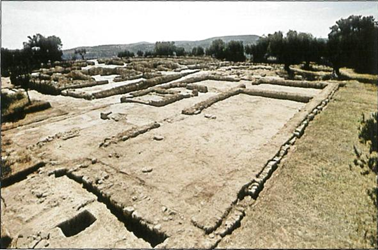Life in Mycenaean Pylos
Σελίδα 4 από 4
he palace administrators were also much concerned with textile production, especially linen but also wool. One series of tablets records the amount of flax that various places were required to contribute to the center. Another lists the groups of women who did the work of spinning, weaving, and decorating linen (and probably woolen) cloth, along with other menial workers like grain-grinders and bath attendants. Most of these women are concentrated at Pylos itself, where there were twenty-eight workgroups comprising a preserved total of 377 women, but others are stationed elsewhere: seven groups (120 women) in the Hither Province, and fourteen groups (142 women) in the Further Province. A different scribe kept track of the groups working in each province; the tablets noted not only the number of workers but how many children they had with them. Still another scribe noted the monthly rations of figs and grain for the Hither Province workers, but such records are not preserved for the Further Province groups.
The perfumed oil industry at Pylos is also a good example of how the center organized the production of important commodities. In the ancient world scented oil was a frequent offering to the gods, and it was also used for medicinal and cosmetic purposes. It was of particular value in a world without soap, where odors could be masked more easily than erased. The Mycenaean world relied for such purposes on olive oil scented with various fragrances. The jars which contained this oil are distinctive (Fig. 15: top center, middle right, and bottom left; Fig. 23). They are called stirrup jars, because the handle resembles a stirrup, and they have a very small mouth, suitable for the small quantities used and easy to stopper. They turn up as offerings in tombs, and they are by far the most common type of Mycenaean pottery found outside Greece. Thus the manufacture and export of perfumed oil was big business, and there is a good deal of information about it in the tablets.

Figure 39. The Northeastern Building
Lists of ingredients give us clues to the various types of perfumed oil and how they were made. Rose perfume, for example, was created by first boiling astringent herbs like cyperus and coriander in the olive oil, to break down its natural resistance to absorbing odors. Then rose petals were steeped in the oil—a later Greek recipe requires several days of steeping, at 1000 roses a day! Such ingredient lists were kept in the archives complex (7-8), but in the oil storerooms 23 and 32 Blegen found inventories and allocation records. These indicate some of the uses to which scented oil was put: it was offered to various gods, given out to the king and to servants, and used to treat textiles (a practice that makes linen, for example, supple and shining as well as sweet smelling).
Further information about scribal organization at Pylos comes from the Northeastern Building (Fig. 39). A fragmentary tablet found in room 98 lists chariot wheels. A different scribe recorded hides (some of them red) for reins and harnesses, and goats or goat hides, and still another listed hides for other purposes. Tablets listing the work groups assigned to various tasks (most clearly related to chariot equipment) are the product of two other scribes, while yet another keeps track of personnel coming in from the provincial districts. Thus a number of administrators were set to the task of monitoring this workshop.
There are also references to some workers "at the seat" of the goddess Potnia ("Mistress") of Horses, and others in the service of a different Potnia, presumably elsewhere. One of these locations could be the shrine (room 93) beside which the workshop was built. From the other finds in the workshop it is clear that materials relating to the activities mentioned were at least stored here, and no doubt they were worked on here as well.
The building was a very late addition to the palatial complex, and was thus built to meet a specific need. It is both large and elaborate, with one particularly big room (99) and extra-wide doorways to rooms 98 and 99, suitable for bringing large equipment in and out. In addition, finds in the rooms complement the information on the tablets about what tasks were performed here: strips of metal may come from chariots, and bright red and yellow patches on the floors of rooms 97 and 98 may have been dye substances, recalling the textual references to red hides.
As in the case of the perfumed oil industry, there are close connections between the Northeastern Building and the central archive. One tablet from the archives complex notes the arrival of supplies destined for the "chariot workshop," thought to be a reference to this building. A tablet concerned with chariot wheels came from room 98, as just noted, but the rest of this series was found in the central archives. It is likely that those tablets were all written in the workshop, where chariot work took place, then moved to the archives complex for storage. In addition, two of the ration tablets found in the archives complex refer to slaves of men listed on a personnel record from the workshop. Thus, while work records were created and kept in the workshop itself, the central archive was heavily involved in supplying needed materials, doling out rations for the workers, and inventorying the results of workshop projects.
(CWS)